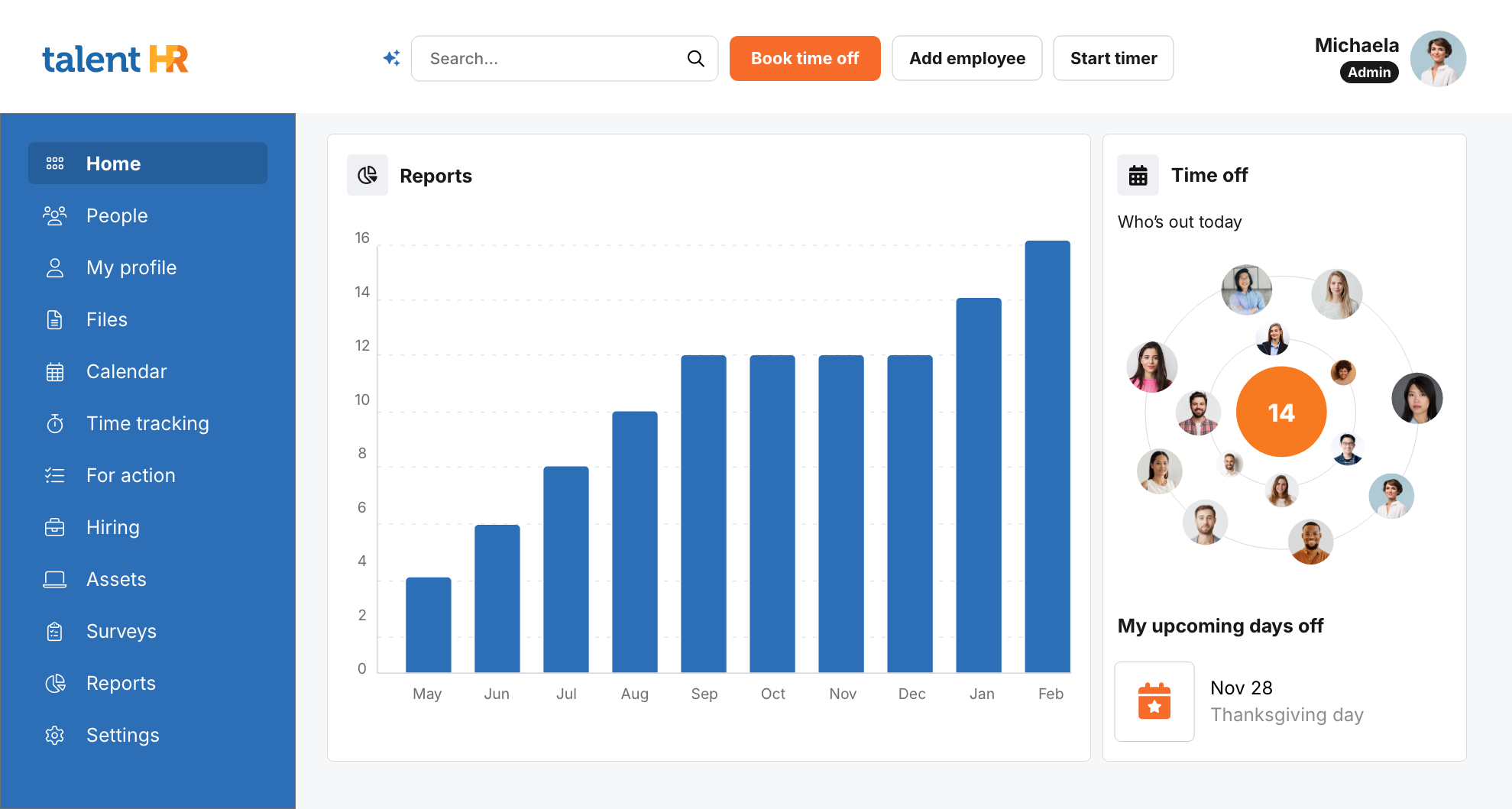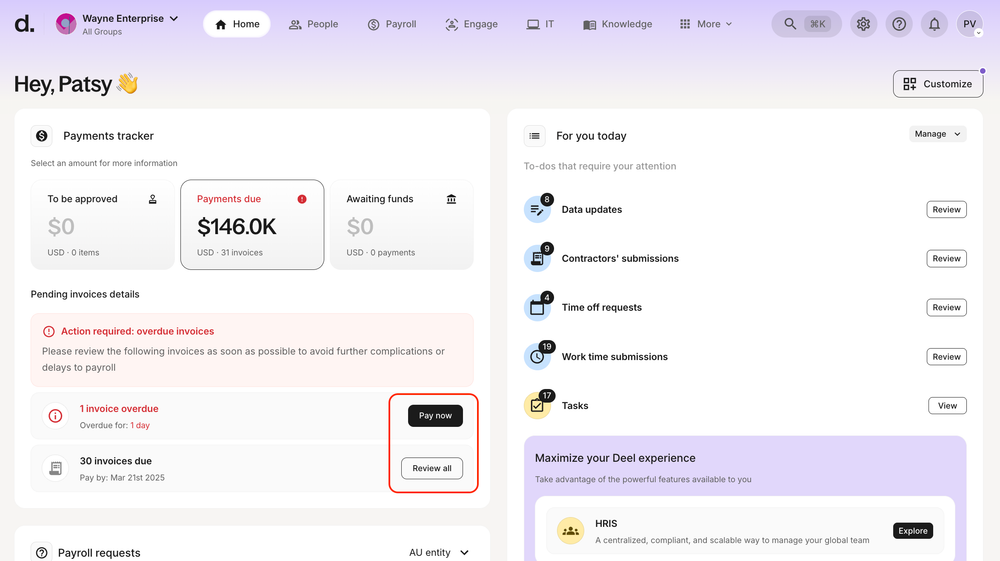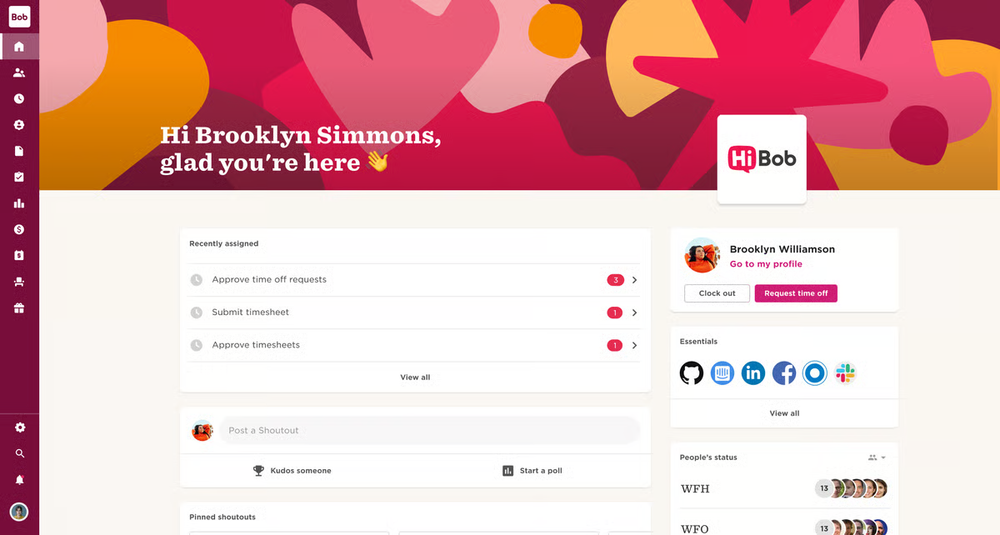
3 Best HR Automation Tools to Save Time (And Money) [2025]
HR automations have surged by 599% in just two years, with bots now handling 39% of employee-facing tasks.
HR has changed what it can do because of this huge growth. Software is taking over more and more of the boring administrative work, which gives HR teams a great chance to focus on what really matters: the experience, engagement, and long-term strategy of their employees.
Despite the rise in automation, 56% of HR leaders say their current tech doesn’t align with their needs. Tools that look like they could be useful are often ruined by platforms that are too hard to use, bad user interfaces, and not enough training. It leads to wasted budgets and unrealized potential. And maybe more time spent than saved.
Yet, some tools actually deliver and save time. In this guide, we’ll walk you through the best HR automation tools for 2025. If you’re looking to speed up hiring, simplify payroll, or upgrade onboarding, we’ll help you find tools that cut costs, eliminate friction, and empower your people to do their best work.
What Is HR Automation? (And Why It’s No Longer Optional)
HR automation refers to the use of software and digital tools to optimize and simplify repetitive, time-consuming HR tasks, such as handling benefits administration, starting a database with the employees, starting or finishing an onboarding process, approving PTO, scheduling performance reviews, scheduling interviews, and more.
Instead of chasing down forms, managing spreadsheets, or manually inputting data across disconnected systems, automation lets HR teams build workflows that run with minimal intervention and complete the tasks in a single interface.
In 2025, automation has become the baseline for any HR function looking to stay competitive, compliant, and helpful.
Key Benefits of HR Automation Tools
Here’s how HR automation systems make a real difference:
- Increased efficiency and time savings: As it automates routine HR workflows (like sending offer letters, collecting e-signatures, or syncing payroll data), you can dramatically reduce administrative time and free up HR for more strategic work.
- Lower rates of human error: Manual data entry increases the risk of costly mistakes, especially in areas like payroll and compliance. Automation guarantees accuracy and consistency, which lowers the risk of legal or financial trouble.
- A better employee experience: Today’s workforce expects positive digital experiences. Actually, a good onboarding experience is very influential in the new employees decision to stay or go after the first months. But once they're past the onboarding, they might then expect an easy way to work their way into the administrative side of the job. Automation offers employee self-service tools, PTO request features, and the ability to see a bank of the days off they have left.
- Based on the numbers: With all your HR data centralized and updated in real time, automation helps you spot trends, identify gaps, and make smarter, faster decisions about hiring, retention, and workforce planning.
The 6 Stages of the Employee Life Cycle →
How to Choose the Right HR Automation Software
Every business is different, so picking the right HR automation software starts with figuring out what's most important to you. The best tool depends entirely on your company’s size, structure, growth plans, and most pressing pain points.
This subsection gives you a useful framework to help you clearly look at your options so you can buy a solution that works for your current workflow and helps you reach your long-term goals.
Key Criteria for your Comparison
Use these criteria to guide your selection process:
- Identify your core needs: Start with the basics. What problem are you trying to solve? Are you looking to automate payroll? Speed up recruiting? Streamline onboarding? Or do you need an all-in-one platform that covers everything, like employee performance reviews and compliance reporting? Clear priorities will narrow the field.
- Integrations: Great tools don’t work in silos. Make sure the software integrates correctly with your existing systems, such as accounting platforms, communication tools, or other HR apps. Well-documented APIs and native integrations save time and prevent data silos.
- Scalability: Choose a platform that grows with you. It doesn’t matter if you're a startup hiring your first dozen employees or an enterprise with international teams. In any situation, your HR software should be able to scale without forcing a complete overhaul down the line.
- User-friendliness: A platform is only as good as its usability. Look for clean, intuitive interfaces that both HR admins, business owners, and employees can use with minimal training.
- Security and Compliance: HR deals with sensitive data. It’s essential to vet how each vendor handles data protection, access controls, encryption, and compliance with local labor laws—e.g., GDPR, HIPA, SOC 2. A trustworthy platform should make this information easy to find.
- Does it do something more?: The best HR automation tools actually do something more than just run automated workflows. The best tools are usually seasoned SaaS HR solutions that may bundle an ATS for hiring, a writer for posting job ads, a dashboard to check on people analytics, and more. When you're comparing tools, make sure you solve all your HR needs with one stroke, and that automation is merely an afterthought of what you really need to do: Sort out HR for good.
The Best HR Automation Tools for 2025
The right HR automation software can unlock growth, raise employee satisfaction, and keep your operations compliant. There is a tool that suits your workflow, whether you are scaling quickly or creating a remote-first team. Below, we’ve organized the top options for 2025 by their standout strengths: affordability, global reach, and workflow flexibility.
TalentHR – Best for Budget-Friendly All-in-One Automation

For companies that want to automate their HR tasks, TalentHR is a strong contender as the ideal HR automation tool. It combines essential features like ATS software, onboarding automation, time-off tracking, talent management, e-signatures, and employee self-service into an easy-to-use platform, and with pricing that’s hard to beat. A clean UI and quick setup make it ideal for teams with or without a full-time HR department.
One of its biggest advantages is cost: the free plan supports up to 10 users, and even the premium tier is priced at just $4 per user per month. TalentHR also supports anonymous feedback tools, mobile access, custom branding, and integrations with third-party platforms.
One of the cons is that some advanced features are still being brought into production. But that's the state of automation: It's moving very fast in 2025. Matter of fact, TalentHR recently rolled out an AI-powered HR assistant that could collaborate with automations not originally planned for.
Pricing:
- Free: $0 (up to 10 users)
- Essential: $2/user/month
- Premium: $4/user/month
Deel – Best for Global Teams and Automating Workflows with Contractors

If you're hiring across borders or managing a remote-first workforce, Deel brings serious potential. It offers global payroll, tax compliance, contractor classification, and Employer of Record (EOR) services.
Deel has plenty of automation workflows already bundled into the product. It offers, for example, an onboarding workflow with a Slack plugin. It also has a time off requests automation workflow, although that's pretty standard in many HR solutions. But Deel is still more of a service platform than an authentic SaaS, and as such, it isn't clear which functions are included with their plans and which require an additional purchase.
On that line, Deel’s pricing structure can be steep for some companies—especially those who want to automate their HR functions and not necessarily mean to use the EOR services. Some users claim that some automated taks, such as payouts or notifications, can be slow or too many for some users, and the modular pricing may feel unclear.
Pricing
- Contractor Management: $49/contractor/month
- EOR: $499/employee/month
- Deel Engage (HR suite): $20/worker/month
- Workforce planning modules: From $15–18/employee/month
HiBob – Good for Configurable Workflows at Scale

Also known as “Bob,” HiBob comes with a highly configurable platform for many HR tools. This workforce management software is particularly suited to mid-sized businesses with distributed teams.
Bob is an HR toolkit that bundles some automation features. Users appreciate its flexibility, onboarding assistance, and ability to create customized and automated workflows. The interface is made up of separate modules that hold features like planning pay, surveys for employee engagement, and performance management.
But HiBob doesn’t publish pricing, which means you’ll need to request a quote if you want to learn ghow much automating your HR processes will cost. Some tools are only useful in certain areas, like a payroll hub that's focused on the UK.
Pricing: Custom, quote-based only.
The Future of HR Automation: The Impact of AI
Automation has already transformed HR by simplifying repetitive key HR processes—like scheduling interviews, approving time-off requests, or sending onboarding documents. But traditional automation has its limits: it follows fixed rules. It’s efficient, but not adaptive. It moves information, but it doesn’t make sense of it.
AI tools for HR change that.
Unlike standard automation, artificial intelligence can analyze, predict, and learn. It brings a layer of intelligence to HR systems that allows them to go beyond execution and into strategy. With AI, your HR tools can:
- Write the best job ads so that you can hire without bias
- Recommend best-fit candidates with a candidate suitability scoring integrated into the applicant tracking software
- Personalize onboarding experiences based on role, location, or department
Many of the platforms mentioned above—such as TalentHR and Deel—are already integrating these capabilities. TalentHR includes an AI-powered assistant that helps HR departments manage repetitive tasks and answer internal questions. TalentHR also has a resource ecosystem that can help HR departments automate, for example, their policies with an AI-generated travel and expense policy.
As this technology gets better, AI in HR is set to move beyond productivity tools and into strategic decision-making, in a way that supports everything, like talent planning and culture design.
Get Instant Help with Our New AI-powered HR Assistant →
Automate HR Processes with HR Software and Save Time and Money
HR automation aims to give people the time and tools to do more meaningful work. As it offloads repetitive, manual, administrative tasks, HR professionals can focus on building a strong culture, supporting employee growth, and driving retention through better experiences.
If you’re not sure where to start, begin by identifying your biggest administrative bottleneck. Is it slow onboarding? Disconnected payroll? Inefficient time tracking? Once you’ve pinpointed the friction, look for a tool that solves that problem first. A focused solution often delivers immediate results and can scale with you as your needs change. You might only require certain automations (like generating employee surveys) down the line and not right now. But the tool should work for any situation. They save time and money from the first moment you deploy them.
In the end, HR process automation is a strategic investment, and companies should leverage the occasion to implement more general HR software.
TalentHR gives you a quick way to quickly add HR automation tools into your company's workflow. You can register now for free and try it. It takes seconds to set it up and start rolling out your HR automations.


